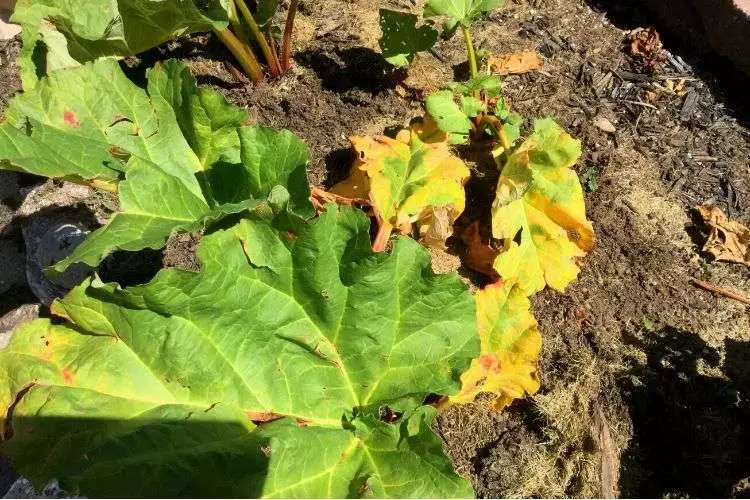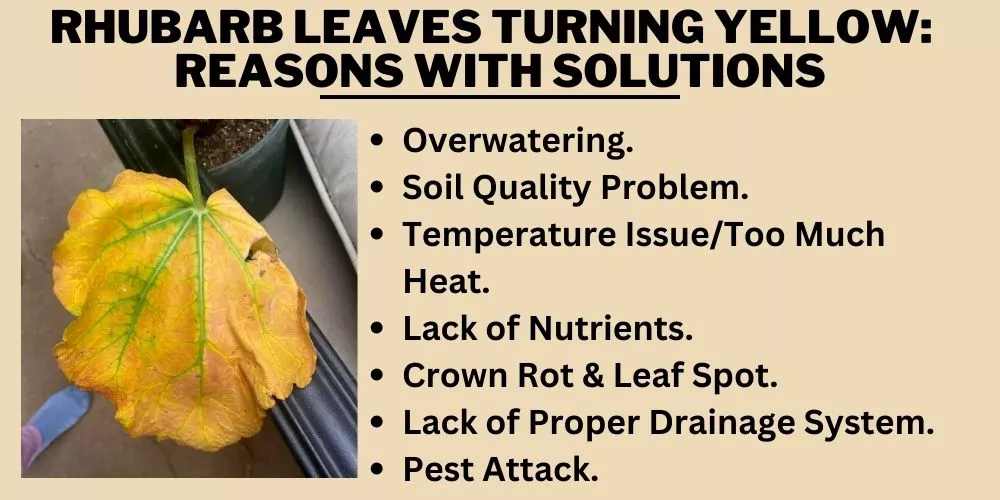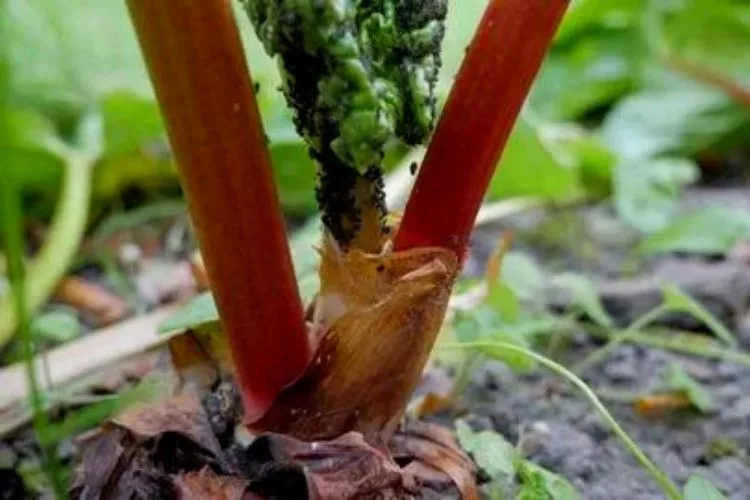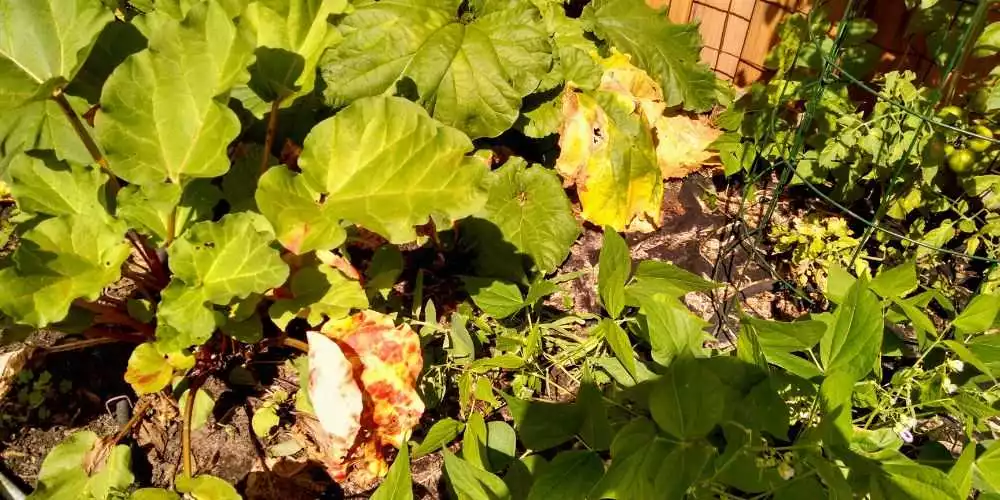Rhubarb is often mistaken as a fruit but is classified as a vegetable derived from the buckwheat family.
As tasty as this reddish/pink stalk ‘fruit’ can be utilized, there can be a few minor issues when trying to grow them. The biggest includes the yellowing of its leaves.
Are your rhubarb leaves turning yellow as well? If yes, then this article is for you. I will discuss some of the most common reasons and also include solutions to help you deal with this condition.
When the leaves begin to go yellow, it’s generally a sign that the plant is under some sort of stress and getting to the bottom of the problem is of top priority.
Furthermore, if the stalks begin to go soft, that’s a sure sign of something more sinister.

There are several reasons that this issue can occur. The most common include overwatering and poor drainage. These 2 complications alone can go on to cause a disastrous domino effect.
Making simple adjustments, such as changing the soil and keeping a closer eye on water frequency, can mitigate and correct them. In this article, we’ll go through all the possible problems and solutions.
Table of Contents
Rhubarb leaves turning yellow: 7 Reasons With Solutions
Rhubarb leaves turning yellow can really be a cause for concern. The plant is shouting out for attention by producing these visual signs.
It’s our job as growers/gardeners to spot these signs and fix them as quickly as possible.
Some issues can be adjusted by simply moving the plant. Other causes need the ‘root’ problem first examined, then identified and finally corrected.
This will ensure that the yellowing doesn’t lead to more damage. Let’s look at the most common causes of leaf yellowing and how to mitigate or manage them.

Overwatering
Overwatering any plant, not just rhubarb, is one of, if not the worst, things you could do. It’s the number one cause for the majority of other snowballing issues to occur. Especially if the soil it is growing in has poor drainage; we’ll get into that issue next.
Overwatering your rhubarb, whether growing in the ground or container, can drown the roots. The soaking roots can go on to cause root rot as well as a few other types of fungal disease and pest infestations.
Rhubarb tends to soak in water and fill its stalks with moisture to keep them plump and fresh. When overwatered, they simply don’t take in any more, and the water sits stagnant around the root system.
Solution
A simple finger probe test is the best way to water a rhubarb plant. You can do this by sticking your finger into the soil beside the stalk base and checking to see how moist the soil is.
If it is bone dry, then it will require a bit of water. If it is still a bit moist, it’s worth waiting a day or so to allow it to dry out. Keep in mind that the warmer months and areas will dry the sil out much faster.
Soil Quality Problem
Another problem that could cause headaches for the avid rhubarb enthusiast is maintaining a balanced pH range within the soil. If the pH is extremely high or low, the soil may not allow nutrient uptake and cause yellowing of the leaves. This can occur with any soil, but all soils can be corrected with the right additives.
Solution
Rhubarb can grow in all 3 pH ‘zones’ considering its ideal range is between 6.0-6.8. So it doesn’t mind being slightly acidic or alkaline as long as it doesn’t creep too far up or down the scale.
It can thrive in sandy or clay-type soil as long as it is mixed in with a bit of compost or any other form of organic matter. This will help improve the overall quality by adding extra natural nutrients and slightly altering the composition.
Temperature Issue/Too Much Heat
Excess heat can also be the cause of yellowing leaves. The plant can become sunburnt and dehydrated, causing the discoloration of the leaves.
Depending on the type of heat also, problems can occur. For example, humid heat can bring on sweating and mold, destroying the plant if left unattended.
Solution
Rhubarb thrives best in stages of variating temperatures. They need at least 500 hours of temperatures between 28-40°F (-2 to 4.5°C) to encourage new leaf buds.
These, of course, are formed during the winter months. In the springtime, they need consistent 40°F (4.5°C) to break the dormant period.
In summer, anything over 75°F (24°C) but within reason will boost the overall growth of vegetation. If the plant is receiving excessive heat, it is best to move it or add some kind of sunshade over the top to relieve it from the harsher temperatures.
Lack of Nutrients
A lack of nutrients will make the rhubarb shed its leaves to conserve energy. More specifically, nitrogen is crucial to the production of energy in the springtime to enable it to boost its growth.
As the leaves are being shed, they will turn yellow and slowly brown off just before falling.
Solution
It’s best to use an all-purpose fertilizer or something like chicken manure and blend it into the soil during the spring. These are generally rich in nitrogen which, as mentioned, promotes growth during the summer.
As the summer season closes and fall sets in, it’s better to use a phosphorus-based fertilizer such as blood meal. Phosphorus will help strengthen the roots enough to gather all the food and water it needs to survive the winter.
Crown Rot & Leaf Spot
Yellow leaves on a rhubarb plant can also be caused by diseases such as crown rot and leaf spot. If these types of diseases are left too long, they can make the leaves go from yellow to red to ensure they fall off.
The crowns will also become brown/black as they decay. The roots will also form large brown spots and holes if left untreated. Leaf spots can be caused by various things, from nematode injuries to insect problems to toxicity.
Solution
The best way to deal with these plant illnesses is to apply a fungicide labeled for the specific disease. Crown rot is tricky because once it takes hold of the plant, there isn’t much you can do to save it.
The crown is where the growth of the plant happens, so if that is disturbed, it makes it difficult for the plant altogether.
If the illness hasn’t traveled too far, you can use either Captan or Aliette. Leaf spot is an issue with the leaves; it is easier to recover from. Generally, something which contains iprodione, chlorothalonil, mancozeb, fludioxonil, azoxystrobin, or penthiopyrad will help with the leaf spot. Simply apply as directed.
Lack of Proper Drainage System
Efficient drainage is essential for most plants, including rhubarb. When water sits stagnant, the root will slowly rot, which causes leaves to begin turning yellow. When a plant’s soil can properly drain, the risk of root rot is severely minimized.
Furthermore, the roots can do as they please without hindrance as they search for nutrients and moisture. Aeration can also be improved via a choice of soil that helps with drainage.
Solution
The easiest way to improve the overall drainage of a rhubarb plant is to pull the plant up and report using better draining soil. Or plan to plant with better draining soil in mind. Use a loam base, but add organic matter that can improve the overall structure. Materials such as manure and compost are ideal for blending into the soil.
Pest Attack
Slugs and aphids love rhubarb because of its ability to hold moisture within its stalks. They are always looking for somewhere they can penetrate and latch on. These pests usually appear when excess watering has been committed.
They get a waft and head on over to begin sucking the life out of the rhubarb. The leaves begin turning yellow as the plant succumbs to the injuries.
Furthermore, the aphids can transmit mold all over the plant, and the slugs chew big holes, making matters worse.

Solution
Dealing with these types of pests can be overwhelming. Luckily they are pretty easy to control if spotted early enough. Insecticides are most effective against aphids.
They are a little tougher to spot, but you can take them down with either neem oil or a homemade soap spray.
A simple soap spray can be made by mixing 2 tbs of liquid soap with 1 cup of olive/vegetable oil. Add these to a bottle, and when you want to use them, take 1 tbs of this mixture and add it to a sprayer with 500 ml of water.
Slugs are resistant to most insecticides, so instead, they need to be scared off by sprinkling certain materials around the plants you want to protect.
These include coffee grounds, wood ashes, sand, crushed eggshells, and diatomaceous earth. These materials throw the senses of the slugs out and keep them away from the plants.
When To Worry Due to Rhubarb leaves turning yellow?
A lot of the mentioned issues can be either mitigated or treated. By planning your rhubarb plant’s growing conditions, you can give it a much better chance of not falling into the hands of any of these problems.
You should worry if it begins producing yellow leaves due to the crown’s damage. The crown area is the regeneration point of the plant.
It controls everything from the uptake of nutrients via the roots to the distribution of those nutrients to the stalks, which enables them to grow effectively.
If the crown so much as forms an early stage of bacterial disease, you want to ensure that it is treated as soon as possible. Another area to treat with care is the roots. They are the parts that search for food and water to store.

On the other end of the spectrum, if you notice that the leaves of your rhubarb are yellowing due to conditions involving excess heat or lack of nutrients, you’re in luck.
These concerns should be corrected, but they shouldn’t cause major headaches. It could be as simple as moving a plant to a better position or applying a little extra fertilizer to boost it the next season.
The plant will do all it can to warn you; it’s up to you to have a look at the signs and investigate. It usually takes a process of elimination to help decide how to deal with the issue.
Always look at the crown and roots first, if possible. If you can rule those 2 out as a cause for concern, you can adjust according to other findings.
Frequently Asked Questions (fAQs)
Can you overwater rhubarb?
You can overwater rhubarb, and it will cause much larger problems if not corrected. Excess water coupled with poor drainage can allow the water underneath the soil pool. The root system will be bathing in that pooled water which causes them to root. Once root rot is not treated, the whole plant can succumb to the injuries.
Should I remove the yellow rhubarb leaves?
Removing some of the yellowing leaves of your rhubarb plant is generally safe. It can help redirect the plants’ energy into focusing on new growth instead of keeping decaying areas afloat. It’s recommended to investigate if they aren’t becoming discolored due to an underlying issue, just to be sure, though.
Conclusion
There are several reasons for rhubarb leaves turning yellow. Some issues can destroy the plant if not treated as soon as discovered. Others can be tinkered with as they aren’t as crucial to the plant’s survival.
It all comes down to looking for the signs and investigating. Make sure to follow this guide to help understand the causes and ways to fix these issues.


